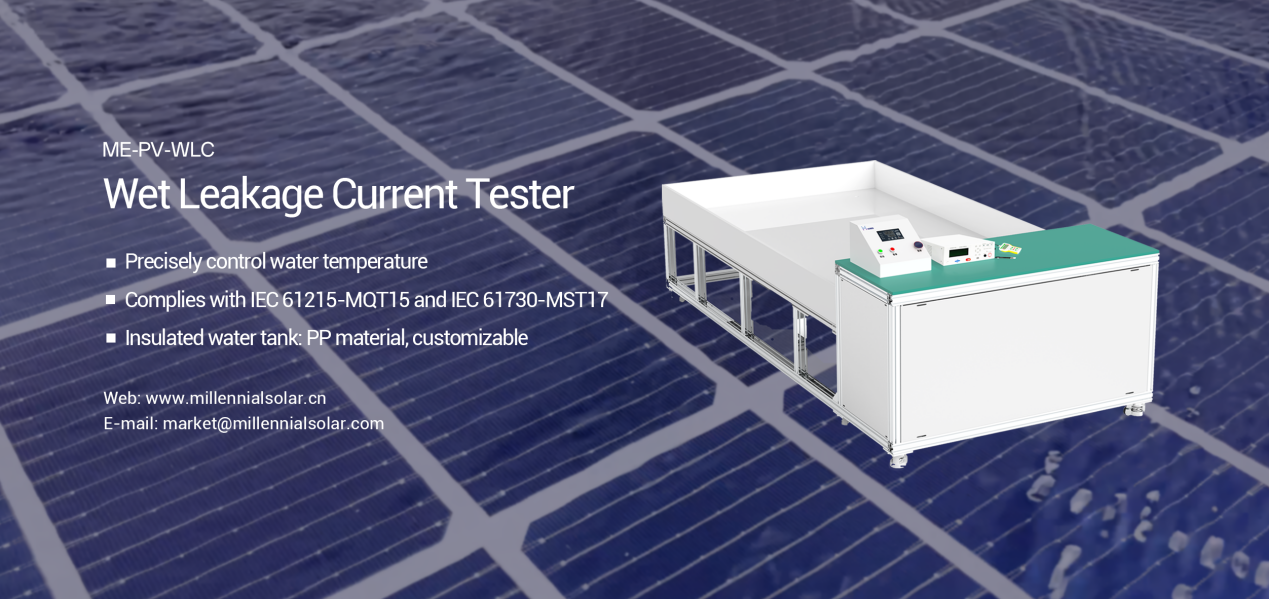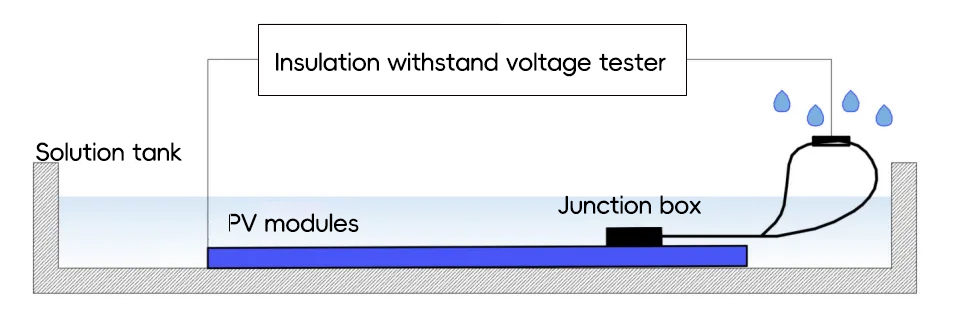
Quantum Efficiency Tester
PL/EL Integrated System
PV-Reflectumeter
3D Confocal Microscope
In-Line Four Point Probe Tester
Four Point Probe Tester
In-Line Thin Film Thickness Tester
Raman Spectrometer
FTIR Spectrometer
Spectrophotometer
Automatic Spectroscopic Ellipsometer
Contact Resistance Tester
Ultra depth of field 3D microscope
Auto Visual Tester
VMM PV Vision Measuring Machine
Solar Cell Horizontal Tensile Tester
Steady State Solar Simulator for Solar Cell
Solar Cell UV Aging Test Chamber
Solar Cell Comprehensive Tensile Tester
Visual Inspection Tester
Wet Leakage Current Tester
PV Module EL Tester
PV Module UV Preconditioning Chamber
Steady State Solar Simulator for PV Module
Current Continuous Monitor
Potential Induced Degradation Test
Bypass Diode Tester
LeTID Test System
Reverse Current Overload Tester
Impulse Voltage Tester
Hipot Insulation Tester
Ground Continuity Tester
Hipot Insulation Ground Tester
Damp Heat Test Chamber
Humidity Freeze Test
Thermal Cycle Test Chamber
Dynamic Mechanical Load Tester
Static Mechanical Load Tester
Hail Impact Tester
Robustness of Termination Tester
Module Breakage Tester
Cut Susceptibility Tester
Peel Shear Strength Tester
Universal Testing Machine (Single-arm)
Universal Testing Machine (Double-arm)
Glass Transmittance Tester
Acetic Acid Test Chamber
EVA Degree of Crosslinking Test System
Junction Box Comprehensive Tester
Drop ball tester
Semi-automatic scanning four-probe tester
Stylus Profilometer
Maximum Power Point Tracker
Perovskite Glass Transmittance Tester
Perovskite P1 Laser Scribing Multifunctional Testing Machine
Perovskite Online PL Tester
Perovskite Online Sheet Resistance Tester
Online Perovskite Film Thickness Tester
Perovskite Process Inspection Workstation
Portable IV Curve Tester
Portable EL Tester
Portable Thermal Imaging Tester
Solar Module Multi-Channel Testing System
PV Inverter Power Quality Tester
Drone EL Tester
IV Tester
IVEL Cell Sorting Machine
Wet Leakage Current Test Under IEC61215 Standard Evaluates Module Insulation Performance
Date : 2024-09-18Views : 710
As the application scenarios of photovoltaic modules continue to increase, environmental challenges are also increasing. When modules are operated outdoors for a long time, environmental tests such as rain, fog, dew, and snowmelt are inevitable. Therefore, the insulation performance of modules in a humid environment is crucial to their safety and reliability. Wet leakage current test can timely detect potential insulation problems, prevent corrosion and leakage caused by moisture intrusion, and avoid safety accidents. Millennial Wet Leakage Current Tester, through advanced testing methods and strict standards, effectively evaluates the insulation performance of modules in a humid environment.

Standards for wet leakage test
The wet leakage test of photovoltaic modules follows MQT15 in the IEC61215 standard and MST17 in the IEC61730 standard. These standards specify the specific conditions, parameters and methods of the test to ensure the reliability of the test results.
Equipment composition
The equipment consists of an insulating water tank and bracket, a control box, an insulation withstand voltage tester, a control box, a conductivity tester, etc. These devices work together to simulate a humid environment and test the insulation performance of the module.
Method and steps of wet leakage test
Preparation before test:
·An insulating tank or container, which should be large enough to place the module and frame horizontally, and made of insulating material
·The tank must contain a solution of water and additives, with a maximum resistivity of 3500Ω/cm
·Temperature control system: Use a heating and cooling integrated machine to ensure that the experimental water temperature is constant at 22℃±2°C
·The spray equipment is filled with the same solution
·DC power supply and insulation resistance tester

Schematic diagram of wet leakage current test
Test steps:
·Immerse the PV module in the solution. The depth of the solution should be enough to cover all surfaces except the junction box entrance. The cable must be sprayed with the aqueous solution.
·Use a suitable connector to short-circuit the module to be tested and connect it to the positive pole of the tester. Connect the negative output line of the insulation tester to the wire leading out of the water tank.
·Apply voltage to the DC power supply and increase it to 500v or the maximum rated system voltage of the module at a rate not exceeding 500v/s. Keep it for 2min, and then test the insulation resistance.
·Connect the positive pole of the insulation tester to the adapter that short-circuits the module to the frame, wait for 5-10s to release the internal voltage of the module, and the discharge is complete.
IEC 61215 standard requirements:
1. For modules with an area less than 0.1㎡, the insulation resistance shall not be less than 400MΩ
2. For modules with an area greater than 0.1㎡, the test insulation resistance multiplied by the module area shall not be less than 40MΩ·㎡
Importance of wet leakage test
The insulation performance of photovoltaic modules in a humid environment is crucial to their safety and reliability. Wet leakage test can detect potential insulation problems in time, prevent corrosion and leakage caused by moisture intrusion, and avoid safety accidents. In addition, regular wet leakage test can also extend the service life of the module and improve the overall efficiency.
Wet Leakage Current Tester

E-mail: market@millennialsolar.com
Wet Leakage Current Tester ME-PV-WLC tests the insulation performance of the module under wet working conditions, and detects whether moisture from rain, fog, dew or melting snow enters the working part of the internal circuit of the module, causing corrosion, leakage, and non-safety accidents.
·The temperature control system can accurately control the water temperature
·Applicable standards: in accordance with IEC61215-MQT15 clauses and IEC61730-MST17 clauses
·Insulating water tank: PP material, customizable volume, with shelves inside
In summary, the wet leakage test is an important electrical test for photovoltaic modules to evaluate their resistance to moisture intrusion. With the Wet Leakage Current Tester, manufacturers can ensure the quality and reliability of solar photovoltaic modules and provide users with efficient and lasting renewable energy solutions by complying with standards such as IEC 61215.

































































